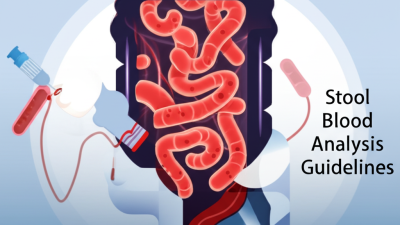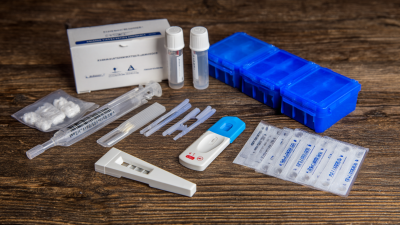How to Effectively Detect Dengue Fever Using Antigen and Antibody Testing Methods
Table of Contents
- Understanding Dengue Fever and Its Impact on Public Health
- Overview of Antigen and Antibody Testing Methods for Dengue
- Step-by-Step Guide to Performing Antigen Tests
- Interpreting Results: Antigen vs. Antibody Test Outcomes
- Factors Affecting the Accuracy of Dengue Testing
- Best Practices for Implementing Testing in Clinical Settings
- Advancements in Viral DNA/RNA Isolation: Analyzing the Efficacy of Macro & Micro-Test Columns in Molecular Diagnostics
- FAQS
- Conclusion
- Related Posts
Dengue fever, caused by mosquitoes and a pretty nasty viral infection, is a big health concern worldwide. That's why catching it early is so important, so we can run the right tests and get people the help they need before things get worse. The Dengue Antigen and Antibody Test has become a pretty essential tool in this fight — it helps spot who’s infected early on, making diagnosis faster and patient care way more effective.

At Jiangsu Macro & Micro-Test Med-Tech Co., Ltd., we totally get how crucial accurate diagnostics are. We've been dedicated to pushing the boundaries of in vitro testing since we started back in 2010 in Beijing. Our focus has always been on R&D, manufacturing, and selling really innovative detection tech. Because we prioritize quality and innovation, we can supply reliable diagnostic solutions that really help combat dengue.
Thanks to our advanced testing methods, healthcare providers can figure out infections with good accuracy, so patients get treated properly and we can prevent outbreaks from spiraling out of control. As we keep working on improving these tests, we’re proud to contribute to global health efforts and make a real difference.
Understanding Dengue Fever and Its Impact on Public Health
Dengue fever, which is caused by the dengue virus and spread mainly through Aedes mosquitoes, is a pretty serious public health issue—especially in tropical and subtropical areas. According to the folks at the World Health Organization, there are around 390 million dengue infections each year, but only about 96 million actually show symptoms. That’s a huge number, and it really highlights how urgent it is to get better at detecting the disease early on so we can deal with outbreaks more effectively. Catching it early is super important—not just for helping the patient recover, but also for stopping it from spreading in communities.
When it comes to managing dengue, using both antigen and antibody tests is pretty much a cornerstone. Antigen tests can detect the virus pretty early on, giving doctors a head start on deciding what to do. On the flip side, antibody tests are great for confirming if someone was recently infected and are useful for keeping track of outbreaks in populations. A study published in the American Journal of Tropical Medicine and Hygiene showed that rapid diagnostic tests—which use both antigen and antibody methods—can boost early detection by as much as 70%. That kind of improvement can really make a difference, allowing for quicker responses. So, adding these testing tools into our toolkit can go a long way in reducing the public health impact of dengue and making outbreak control a lot smoother.

Overview of Antigen and Antibody Testing Methods for Dengue
When it comes to detecting dengue fever, doctors and labs typically rely on two main testing methods: antigen tests and antibody tests. Antigen tests, like the handy lateral flow assays (LFAs), are super convenient—they’re quick, easy to use, and great for on-the-spot diagnosis. These tests work by spotting viral proteins early on, which is key for getting patients the right treatment right away. Over time, LFAs have become more popular, especially in places where resources are tight, because they’re fast and don’t need fancy equipment.
On the flip side, antibody tests look for the body’s immune response. They’re used to figure out if someone had dengue before or might have some level of immunity. Thanks to advances in tech—things like asymmetric PCR and suspension bead arrays—these tests are now better than ever at accurately identifying the different dengue virus types. When you combine these blood tests with clinical info and other lab results, you get a pretty solid picture of what's going on. This combined approach really helps especially with kids, making diagnoses more reliable.
As dengue continues to be a big challenge for public health, it's clear that using both antigen and antibody tests together is pretty much essential. It’s all about improving how we manage and control the disease more effectively, especially in tough environments where quick, reliable testing makes a huge difference.
How to Effectively Detect Dengue Fever Using Antigen and Antibody Testing Methods
| Testing Method | Type | Detection Window | Sensitivity (%) | Specificity (%) |
|---|---|---|---|---|
| NS1 Antigen Test | Antigen | 0-7 days | 80-90 | 95-100 |
| IgM Antibody Test | Antibody | 5-14 days | 70-80 | 90-95 |
| IgG Antibody Test | Antibody | 2 weeks and beyond | 60-70 | 85-90 |
| RT-PCR Test | Nucleic Acid | 0-7 days | 90-95 | 95-100 |
Step-by-Step Guide to Performing Antigen Tests
Testing for dengue fever using antigen tests can be a quick and fairly reliable way to catch the virus early on. So, the first thing you wanna do is gather all your supplies — the test kit, blood samples, and any reagents you'll need. Make sure everything's sterilized and that the environment is nice and clean — ideally, a proper lab setup. Oh, and don’t forget to explain the whole process to the patient and get their consent. It’s always good to reassure them and make sure they’re comfortable with what’s happening.

Once you’re all set, the next step is to collect a blood sample. You might do this via a fingerstick or a venipuncture, depending on what the test requires. After getting the blood, follow the instructions on the kit and apply the sample to the test strip or device correctly. Then, just set a timer and wait for the results to develop. When time’s up, take a good look at the strip — compare it to the control line to see if dengue antigens are present. Don’t forget to record your results properly, and if needed, recommend the next steps for medical care. Easy peasy, right? Just a few steps to catch the virus early and help get your patient the care they need.
Interpreting Results: Antigen vs. Antibody Test Outcomes
When it comes to figuring out if someone has dengue fever, picking between antigen and antibody tests is pretty important — it really influences how we interpret the results. For instance, antigen tests that look for the dengue NS1 protein tend to be most accurate during the first few days after symptoms start. Plus, they can give you results pretty quickly, which is super helpful when you need to make fast decisions about treatment. If the antigen test turns out positive, it means there's an active infection, so doctors can jump right into managing it without delay.
Now, on the flip side, antibody tests are a bit different. They check for the immune response, like IgM and IgG antibodies. Usually, IgM antibodies show up about a week after symptoms begin—so if you test positive for IgM early on, it’s a good sign you recently caught dengue. IgG antibodies, on the other hand, can suggest a past infection or a longer-lasting one. But keep in mind, a negative antibody test doesn’t automatically rule out dengue—sometimes you need to wait and test again.
All in all, understanding when symptoms started and choosing the right test at the right time is key to getting an accurate diagnosis and figuring out what to do next.
Detection of Dengue Fever: Antigen vs. Antibody Testing Methods
Factors Affecting the Accuracy of Dengue Testing
When it comes to dengue testing, there are a few key factors that healthcare providers really need to keep in mind. For starters, timing is everything. If you test too early or too late, the results might not tell the full story. For example, antigen tests tend to work best within the first week after symptoms start—that's when the viral load is at its peak. On the flip side, antibody tests, which can tell you if someone has had dengue in the past, usually don’t give reliable results until around the second week. So, choosing the right test depends a lot on when the patient first noticed symptoms—that’s pretty important for getting an accurate diagnosis.
And then there's the quality of the testing kits themselves. Using validated, approved kits from reputable sources makes all the difference in the accuracy of the results. Plus, the skills and experience of the lab techs handling the tests really matter—they can make or break the reliability of the outcome.
A couple of quick tips: Always take into account when the patient's symptoms started to pick the right testing method. Stick to testing kits from trusted, certified manufacturers—that way, you're more likely to get trustworthy results. Oh, and it helps to have experienced technicians running the tests—they'll know how to handle everything properly and interpret the results correctly.
Best Practices for Implementing Testing in Clinical Settings
Getting effective dengue fever detection up and running in the clinic isn't just about picking any test — it's about having a solid strategy for antigen and antibody testing. The World Health Organization points out that dengue is a major cause of illness in tropical and subtropical areas, hitting millions of folks every year. From what I’ve seen in studies, using rapid diagnostic tests (RDTs) can really speed things up when it comes to diagnosis — they show sensitivity rates around 80% to 90% if you’re doing it right. But honestly, to get the best results, it’s super important to follow the best practices during implementation.
First off, making sure that healthcare workers know how to interpret these tests properly is a must. The CDC stresses that misreading results can lead to wrong clinical decisions — and nobody wants that. Also, it helps a lot to integrate the testing procedures smoothly into the existing healthcare workflow. This means keeping the testing environment clean, handling samples carefully, and cross-checking results with the patient's symptoms — all of these steps can really bump up the accuracy. And let’s not forget, timely reporting and follow-up are key. Standardizing these processes ensures we can catch any outbreaks early on and provide the proper care for those who need it most.
Advancements in Viral DNA/RNA Isolation: Analyzing the Efficacy of Macro & Micro-Test Columns in Molecular Diagnostics
Recent advancements in the field of molecular diagnostics have significantly enhanced the processes involved in viral DNA and RNA isolation. The efficacy of nucleic acid extraction has been a focal point, particularly with the introduction of macro and micro-test columns that promise to revolutionize the quality and speed of sample processing. According to a 2021 report by the Global Market Insights, the rise in infectious diseases and genomic studies has propelled the demand for efficient extraction methods within clinical laboratories, which underscores the necessity for reliable tools in viral detection.
Utilizing advanced extraction kits that facilitate nucleic acid purification is critical in clinical in vitro detection. These kits are designed to enhance the extraction and enrichment of nucleic acids from various sample types, including blood, saliva, and tissue. A study published in the Journal of Clinical Microbiology indicated that optimizing extraction protocols can improve the sensitivity of viral detection assays by up to 30%. This improvement is a vital consideration for laboratories aiming to remain at the forefront of diagnostic accuracy, particularly during viral outbreaks where timely results can impact treatment decisions.
The comparative analysis of macro and micro-test columns reveals distinct advantages in their application. Macro-columns are designed for larger sample volumes, which is beneficial when processing a high throughput of samples, while micro-columns can be advantageous for smaller sample sizes due to their compact design and efficiency in nucleic acid binding. The adoption of these column technologies aligns with the industry's trend toward automation and scalability, allowing laboratories to better manage their workflow and respond rapidly to emerging clinical needs. As the molecular diagnostics landscape evolves, investing in innovative extraction solutions will be critical for maintaining high standards of patient care.
FAQS
: Dengue fever is an illness caused by the dengue virus, which is transmitted through Aedes mosquitoes.
The World Health Organization estimates that there are 390 million dengue infections each year, with 96 million of these cases manifesting clinically.
The primary testing methods for diagnosing dengue fever are antigen testing and antibody testing.
Antigen tests detect viral proteins during the early stages of infection, enabling timely clinical decisions and intervention.
Advancements such as asymmetric PCR and suspension bead array techniques have improved the sensitivity and specificity of identifying dengue-specific antibodies.
Early detection is vital for improving patient outcomes and controlling the spread of the disease within communities.
Steps include preparing materials, obtaining informed consent, collecting a blood sample, applying it to the test device, waiting for results, and recording the findings.
Rapid diagnostic tests can enhance early detection rates by up to 70%, leading to timely intervention and mitigation of the public health burden.
Combining antigen and antibody testing with clinical data creates a comprehensive diagnostic algorithm, improving diagnosis accuracy, especially in children.
LFAs are particularly useful in resource-limited settings where quick and accessible testing is essential.
Conclusion
Dengue fever continues to be a big public health challenge around the world, and catching it early is super important for quick action. The article, "How to Effectively Detect Dengue Fever Using Antigen and Antibody Testing Methods," dives into different testing approaches to spot this viral infection. It offers a pretty clear overview of Dengue antigen and antibody tests, including a step-by-step guide on how to do antigen tests and understand the results. Knowing the difference between positive antigen and antibody results is key to getting an accurate diagnosis, not to mention being aware of factors that might affect test accuracy.
Thanks to Jiangsu Macro & Micro-Test Med-Tech Co., Ltd.'s focus on cutting-edge detection tech, healthcare pros can follow best practices right in the clinic. By using their advanced in vitro diagnostic reagents, clinicians are better prepared to deal with Dengue fever, which means better patient care and stronger public health efforts overall.
Related Posts
-

Innovative Solutions for Accurate Helicobacter Pylori Antigen Detection in Gastrointestinal Health
-

Step-by-Step Guide to Understanding H Pylori Testing: Stool vs. Blood Analysis
-

What You Need to Know About Wholesale Hepatitis B Rapid Test Kit Manufacturers
-

Future Trends in Gene Cyp2c19 Market Analysis for 2025 and Beyond
-

Ultimate Guide to the H Pylori Antigen Rapid Test Kit: What You Need to Know
-

Exploring Creative Alternatives to Sourcing Wholesale At Home Fish Test Suppliers


